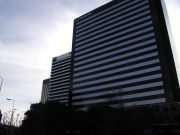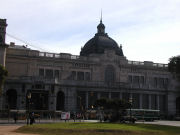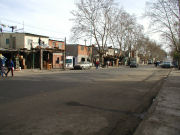Buenos Aires – Quite literally, there is a divide between neighborhoods on opposite sides of the tracks. I set out originally planning to check out two places for empanadas from the Tucumán area in the northwest. I’ve been following the guidance in selecting places of both recommendations of friends and the writings of Dereck Foster, food and wine writer for the local English language newspaper, the Buenos Aires Herald.  The two spots closest to each other that he’d recommended were in the San Nicholas area and the Retiro neighborhood. Unfortunately the former has been replaced by a shoe store and I couldn’t find the latter. More empanadas another day.
The two spots closest to each other that he’d recommended were in the San Nicholas area and the Retiro neighborhood. Unfortunately the former has been replaced by a shoe store and I couldn’t find the latter. More empanadas another day.
San Nicholas is basically the “downtown” of Buenos Aires. It is predominately office buildings, including many high-rises that house the headquarters of companies like IBM, Sun Microsystems, and Movistar (major cellphone company here). There are numerous restaurants, many oriented around the business traveller, offering quick but tasty lunches from a variety of international cuisines, and dinners at somewhat earlier hours than the rest of the city. That said, I should note that it’s not unusual in BA for restaurants not to open for dinner until 8 or even 9 o’clock in the evening.  Most locals won’t be caught out eating prior to about 10 p.m. and it’s not out of the ordinary to end up with dinner plans an hour or two after that!
Most locals won’t be caught out eating prior to about 10 p.m. and it’s not out of the ordinary to end up with dinner plans an hour or two after that!
Wandering down Esmeralda Street (how could I not head to an, umm, “bewitching” restaurant on that street?) I ran firmly into the train tracks and the Retiro train station. As the number I was looking for looked to be a few more blocks on, I circled the gigantic train and bus station and found myself in another world (in which I couldn’t find Esmeralda again).  Retiro is a neighborhood I know very little about – it’s listed as a tourist destination by most guidebooks, but with little said about it other than it’s a place to purchase authentic artesanal items… whatever that means. While I only saw a few square blocks of the neighborhood, that part of it (behind the train/bus station) was quite poverty stricken, with collapsing buildings, dirt streets, abandoned cars, and a very cheap flea market that seems mostly frequented by the local poor. I can’t say that I felt unsafe skirting the area, but I wouldn’t have wanted to venture far into the winding paths without someone local who I trusted.
Retiro is a neighborhood I know very little about – it’s listed as a tourist destination by most guidebooks, but with little said about it other than it’s a place to purchase authentic artesanal items… whatever that means. While I only saw a few square blocks of the neighborhood, that part of it (behind the train/bus station) was quite poverty stricken, with collapsing buildings, dirt streets, abandoned cars, and a very cheap flea market that seems mostly frequented by the local poor. I can’t say that I felt unsafe skirting the area, but I wouldn’t have wanted to venture far into the winding paths without someone local who I trusted.
 I didn’t see much in the way of artesanal items, but there were some wonderful little vegetable stands, and I took advantage of spotting some items I haven’t seen in other markets and bought a couple of different types of papas andinas, or Andean potatoes. I’ll talk a bit more about these after I actually try them out, and maybe find out exactly what varieties they are (I tried a couple of google image searches just to match pictures and didn’t see the particular ones I bought). Though I’m pretty sure the young lady who packed up my potatoes for me (and gave me full kilos of each rather than the half kilos I asked for) charged me a bit more than she’d have charged someone who looked a bit poorer, I paid less than a dollar per kilo and didn’t begrudge her any extra.
I didn’t see much in the way of artesanal items, but there were some wonderful little vegetable stands, and I took advantage of spotting some items I haven’t seen in other markets and bought a couple of different types of papas andinas, or Andean potatoes. I’ll talk a bit more about these after I actually try them out, and maybe find out exactly what varieties they are (I tried a couple of google image searches just to match pictures and didn’t see the particular ones I bought). Though I’m pretty sure the young lady who packed up my potatoes for me (and gave me full kilos of each rather than the half kilos I asked for) charged me a bit more than she’d have charged someone who looked a bit poorer, I paid less than a dollar per kilo and didn’t begrudge her any extra.
[…] Buenos Aires – There’s a new kid in town, a second English language newspaper, the argentimes. It’s written by and for the “youth market” with an emphasis on social and political issues and eco-tourism. I missed the first issue in early June, but picked up the second issue yesterday at the restaurant I’ll be reviewing next. It’s a well written, well edited paper, and definitely has a viewpoint different from The Buenos Aires Herald, the long term, fairly staid English language paper here. For a paper based in Buenos Aires, and with its aims, I found some of the content odd – two of the three political and social issue stories were about Bolivia (maybe because the two editors have spent the last few years living in Bolivia and can’t get that beat out of their minds?). On the other hand, I got a solid sense of some of what’s going on there. There was also a fascinating piece about the history and some new social programs in Villa 31, which turns out to be the name of the shantytown behind Retiro station. The restaurant review was of a North American run expat sports bar – possibly interesting news for any expats who don’t already know the place, but given the paper’s stated aim of “dedicated to increasing awareness of the cultural, economic, political, social and environmental sides of Argentine life”, I find it an odd choice. […]